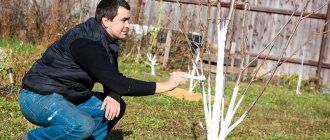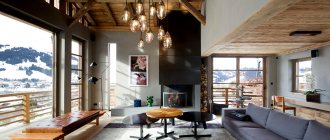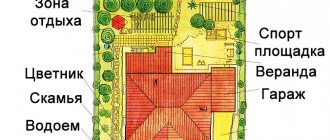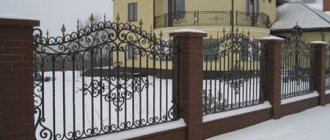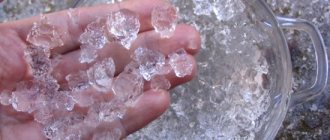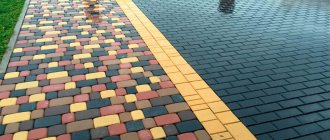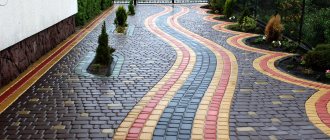Does hot water freeze faster or not?
In general, this fact has been known for a very long time, since the times of Aristotle, as well as Descartes. However, there was no scientific evidence. Only in 1963 did significant work begin, the main task of which was to find out why this was happening.
Does hot water freeze faster or not:
- According to physics, this contradicts the first law of thermodynamics, which states that one energy flows into another. According to the first law of thermodynamics, a heated liquid must pass a cooling temperature before it hardens, and accordingly, the hardening time should be much longer.
- However, in practice it happens differently. A schoolboy thought about this and asked his physics teacher the corresponding question. The boy was making ice cream at home and noticed that a glass with a warm liquid froze much faster than one with a cool liquid, given the same composition of the substance.
- Then the teacher just laughed at the guy, saying that this contradicts the first law of thermodynamics and is therefore impossible. After a visit to the school of the famous physicist Osborne, the boy asked him the same question, which interested the scientist.
Ice
Should I buy a skating rink or make it myself?
Considering the fact that often the cost of rollers of even the simplest modification is estimated at 4,000-7,000 rubles, then the purchase, to put it mildly, does not seem advisable, given the required amount of work within the garden plot. Therefore, for arranging small or even medium-sized areas, making a skating rink yourself can be considered optimal. But, for large areas and for those people who actually plan to make money using such tools, it is advisable, on the contrary, to buy a finished product that is guaranteed to last a long time.
Read on topic: Crushed stone spreaders
By the way, here is a video that clearly shows how to work with the roller, its structure and principle of operation. Be sure to take a look, even if you are planning to design it yourself, you will find a lot of useful information.
Which water freezes faster, hot or cold?
It was in 1963 that Osborne, together with the boy, began to study this issue, as a result of which an article was published in the magazine educacion. At the same time, an exact answer as to why a heated liquid solidifies faster than a cold liquid has not been obtained.
Which water freezes faster, hot or cold:
- According to some scientists, a warm solution in a refrigerator with a thermostat turns into a solid state much faster only for the reason that the refrigerator begins to freeze more strongly when a signal is received that the temperature in the chamber is increasing.
- This does not happen with cooled liquid, since its temperature is much lower, and the thermostat operates as usual, without reducing the temperature of the refrigerant. However, this version has not been confirmed for the reason that a heated liquid under normal conditions in air also hardens much faster than a cold one.
- Accordingly, there is no thermostat in normal street conditions, so the cold does not increase.
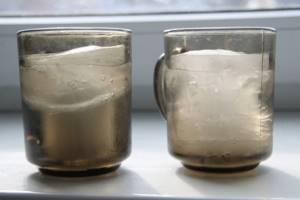
Ice
Technology for creating an asphalt skating rink with your own hands
Iron pipe roller
In order to make a skating rink from a pipe, we will need the following tools and materials:
- Bulgarian
- Welding machine
- Electrodes
- Metal wheel and grinding wheel
- Iron pipe with a diameter of 30 cm (pipe length 1 meter)
- Metal corner 50 mm wide and at least 2 meters long
- Bearings – 2 pcs.
- 10 – centimeter shaft for bearings
- Metal pipe with a diameter of 30 mm and a length of 2.5 meters
- Iron sheets 30*30 cm – 2 pcs.
- Sand
So, let's move on to the technology of creating an asphalt roller with your own hands.
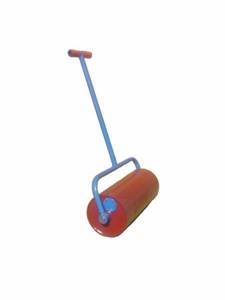
Iron pipe roller
First of all, we weld a 30*30 cm sheet of iron to one of the ends of the 30-centimeter pipe. The sheet should be the same diameter as the pipe, so we cut off the remaining corners with a grinder and carefully grind the joint itself. As a result, we got a pipe with one welded end (the so-called bottom).
Now we place the pipe bottom on the soil and pour sand into it, compacting it thoroughly, because The more sand you put in, the heavier the asphalt roller will be.
Using the same technology, we weld a second sheet of iron on top of the pipe, then cut it off and carefully grind it.
In order to be able to add sand to the roller container later (when it is compacted well), it is recommended to make a threaded hole and a screw-on plug on one of the sides. The construction of the most executive part of the skating rink is ready.
Next we move on to the mechanism that will make the roller rotate. We take 2 bearings and drive a shaft into them (5 cm each), after which we secure it by welding.
After this, we take a metal corner and set it into three parts: 40 cm, 40 cm and 110 cm. We weld all 3 parts in the letter P (40 cm sections on the sides, 110 in the middle) and weld the outer parts of the bearing structure to the sides of the finished frame.
Now we return to the roller itself, calculate the center of the cylinder circle on both sides and at this place we weld the bearing shaft, which is welded to the bearing itself.
Well, in the end, we weld a metal pipe to the U-shaped frame, which we cut in advance and weld with the letter “T” (longitudinal part 2 meters long, transverse 0.5 meters) to make a comfortable handle.
At this point, the construction of a manual asphalt roller with your own hands is considered complete.
It should be noted that you can do without creating a bearing mechanism for the roller; instead, simply make holes in the sides of the U-shaped frame into which the shaft will be inserted. The disadvantage of this design is that the roller will be difficult to push, and therefore there will be no question of any comfort!
Why does hot water freeze faster?
However, it was possible to find out that the heated liquid, due to the presence of a large amount of vapor above the surface, hardens much faster due to the fact that vapor is formed on the surface and the volume of the liquid in the container decreases. This allows you to freeze a smaller amount of liquid, which is much easier than freezing a larger amount. However, in practice the loss of volume is insignificant, therefore the hardening process cannot be considered justified.
Why hot water freezes faster:
- Many scientists agree that heated liquid, due to the presence of vapors, begins to turn into ice faster. Ice droplets above the surface fall into the water, which contributes to the formation of an ice crust, which causes a rapid process of transformation into ice.
- Scientists have found that if you place a container with warm liquid on snow or an ice crust in a refrigerator, it begins to melt, as a result of which the contact between the container, the water in it, and the refrigerator increases, thereby increasing the contact area, as a result which causes rapid freezing of warm water.
- Cooled water does not have such an effect due to the fact that the snow cushion under it does not melt, and the process of turning into ice occurs much more slowly. In addition, it was possible to find out that cold liquid, when the temperature decreases, begins to solidify in the upper part. As a result, the processes of mixing water inside deteriorate, and therefore the process is delayed. The heated liquid begins to freeze from below, thereby enhancing the processes of convection and heat radiation.
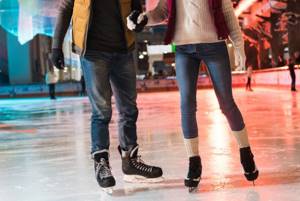
On the rink
How to choose a place to work?
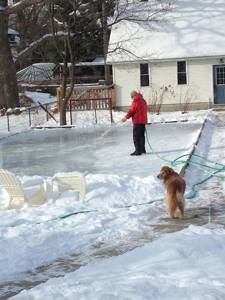
If you have a multi-story building with a sports ground near it, then a homemade skating rink can be equipped there. Naturally, you will need permission from all residents and the housing office. The surface that will be used for the skating rink must be level, without any hills or holes. It is desirable that it has a slight slope. In this case, the water that forms after the ice melts will drain without harming the surface of the site. Naturally, it is necessary to decide on the size of the future skating rink. The site should be well lit, have full access and be far from the road.
Why is the skating rink filled with hot water?
Scientists have found that if you turn on additional mechanical averaging of water in hot and cold containers, the cooled water will freeze much faster. This is due to the fact that a dense ice crust will not form.
Why is the skating rink filled with hot water:
- Chemists also tried to explain this paradox by the fact that inside the heated liquid there are dissolved substances that settle to the bottom, and clean water appears on top. Everyone knows that saline solution hardens at a lower temperature than distilled water.
- Thus they tried to explain this paradox. Accordingly, cooled water is harder and has pronounced ions contained throughout its volume. Moreover, in a hot liquid, the dissolved salt is preferably located in the lower part of the solution.
- Thanks to this, the upper part hardens faster, transferring a reduced temperature to the lower layers of the liquid.
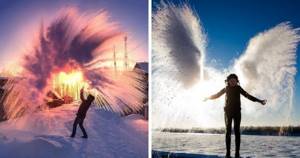
Freezing day
Features of base preparation
All work should be carried out in suitable weather. The base must be clear of debris, snow and ice. Only now can we begin to prepare it. That is, you need to pour snow onto the cleared area and compact it well. The thickness of the layer should be at least 5 cm. The snow must be compacted very tightly so that you can walk on it freely without falling through. If the site does not have sides, you can make them yourself from snow or wooden boards. If the base is prepared, you can start pouring.
Does cold or hot water freeze faster?
Scientists have found that if you constantly mix warm and cold water, the cold liquid will turn into ice much faster.
Cold or hot water freezes faster:
- Many scientists believe that in warm water the bonds between molecules are stretched, so the hydrogen molecule is also more voluminous in space. When the water cools sharply, these bonds are broken, with a very sharp drop in temperature.
- This is what causes the rapid freezing of warm water. It is believed that a hot liquid contains less dissolved gases than a cold liquid. It is precisely because of the change in the composition of the hot liquid that it quickly turns into ice.
- There is still no clear and definitive answer to this paradox. Studies were conducted in 2012-2017 that confirmed the paradox or refuted it. In 2021, in the journal scientific reports, there is a reference to materials that cold water turns into a solid state more slowly than heated water.

A kind of research was carried out, according to which 400 ml of water were frozen at different temperatures. According to these studies, hot liquid cooled faster than cold liquid. In 2021, a hypothesis was published that the Mpemba effect, which concerns the heating of a cooled system, does not correspond to equilibrium. Therefore, all the basic laws of physics and thermodynamics do not fit this paradox.
What types of skating rinks are there?
There are many criteria for classification, take at least the following:
- Weight.
- Processing width.
- Composition of the internal filler.
- Management principle.
- Functional purpose.
Remember that the weight of the drum greatly influences the efficiency of the compaction job. For example, the site has heavy soils, so only heavy-duty units should be used. Weight for hard soils somewhere up to 120 kg is considered optimal. Sandstone requires much less attention, so you can easily handle weights up to 50 kg.
Also, do not forget about the working width, depending on the area, shape, area, structure and design, layout, all this influences the choice. The standard for small lawns is a grip of 50 cm. For compacting wide sidewalks and large areas, rollers 100 cm wide are suitable. Well, they can already be considered professional; they are often used when preparing the base for sidewalk paths or lawns for sports grounds and others.
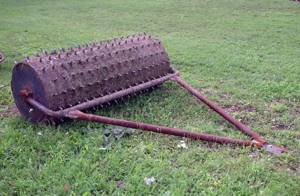
In general, the following types of skating rinks can be distinguished:
- Manual roller for soil compaction.
- Lightweight rollers that require effort from the operator.
- Special aeration rollers.
We’ve sorted out the types and varieties of hand rollers; we can even give examples: AL-KO GW 50, an aerator roller called “Hedgehog”, a “Giant” roller with a wide grip and a large mass.
Ice skating rink
The collector system and the heat exchanger are two components of the ice skating rink. The purpose of the collector system is to supply refrigerant and distribute it evenly throughout the heat exchanger tubes of the skating rink. To create a collector, pipes made of steel or polyethylene with a diameter of 150–200 mm are used. They are laid according to the three-pipe “Tisherman pressure equalizer” scheme.
The heat exchanger is built from polyethylene pipes (PE 80) with a diameter of 16–25 mm, which are placed along the long side of the rink with a pitch of 70–100 mm. A loop is made from the tube and welded into the supply and return manifold. The length of the loop is actually the length of the rink field.
Leisure products at the best price!
Pool liner 4*4m SportStyle RUB 13,400
More details
Pool film 3*2m SportStyle 6,400 rub.
More details
Waterproofing, industrial geomembrane SportStyle 350 rub. / m sq.
More details
Swimming pool awning 400 rub. / m sq.
More details
Pool cover made of fine mesh RUB 350. / m sq.
More details
Pond film 700 microns thick 380 rub. / m sq.
More details
A stationary ice rink must be equipped with a cooled plate. It is possible to install such a slab without resorting to arranging a concrete base and concreting, which is suitable for both a seasonal skating rink and an ice-covered area that operates all year round.
For an ice skating rink that operates throughout the year, the heat exchanger of the field is covered with a layer of sand, then it is filled with water, freezing, it is set in the ice mass. This option reduces the cost of construction and electricity costs, because the heat transfer coefficient increases.
When arranging waterproofing for an ice skating rink, it is necessary to protect the cooled slab from the influx of heat from the ground; for this purpose, lay a layer of thermal insulation made of foam plastic or extruded polystyrene foam. The structure of the ice field must have layers of drainage and waterproofing.
If you plan to use the skating rink all year round, you need to equip it with a soil heating system: it will protect the base from freezing and various deformations.
For small ice rinks (approximately 150 m2), 40–50 kW of refrigeration power is sufficient at a coolant temperature of 12 °C and an outdoor temperature of +35 °C. For an ice hockey arena with an area of 1800 m2, you will need 300–450 kW.
Today, refrigeration equipment is represented by chillers exclusively on rotary compressors (scroll, centrifugal and screw). The level of quality and reliability of chillers has increased, and the dimensions and weight of refrigeration units have decreased.
Scroll compressors are installed on chillers with a cooling capacity of up to 160 kW, screw compressors are installed on refrigeration units with a cold production of over 180 kW.
In addition, all chillers are available in ozone-safe versions based on R-134A and R-404A freons.
Recommended articles to read:
- Pool liner: characteristics and installation methods
- Basement waterproofing: types, features and installation rules
- Waterproofing for walls: types, features, recommendations

